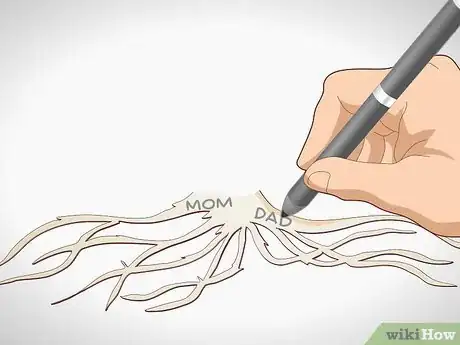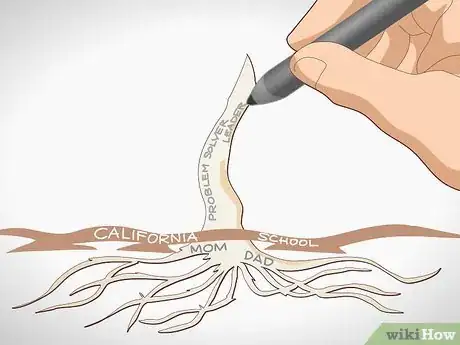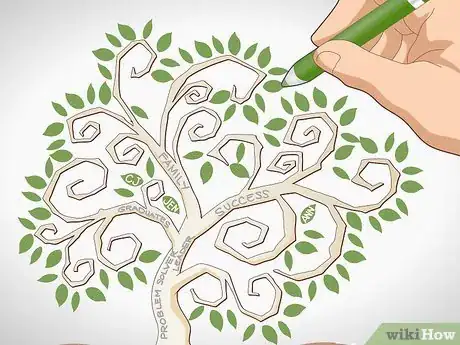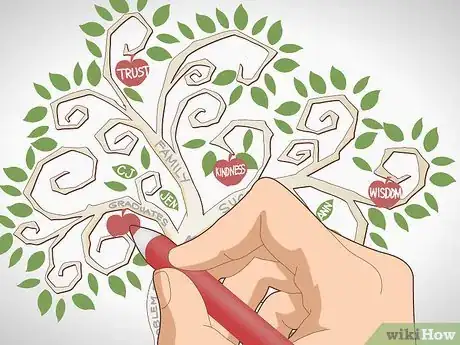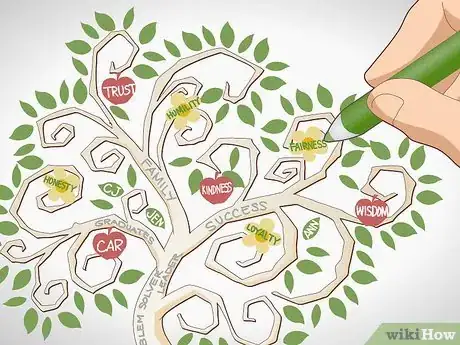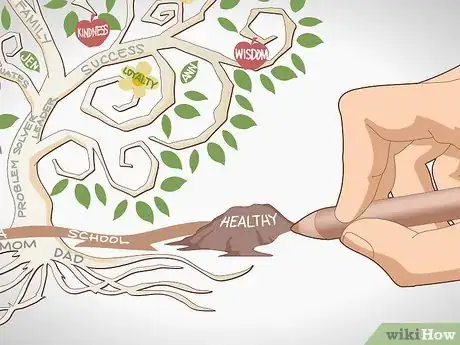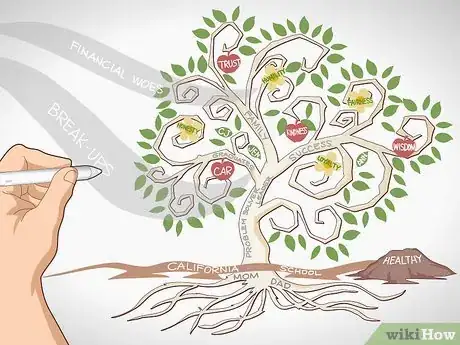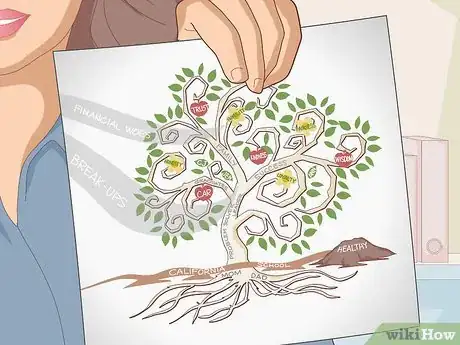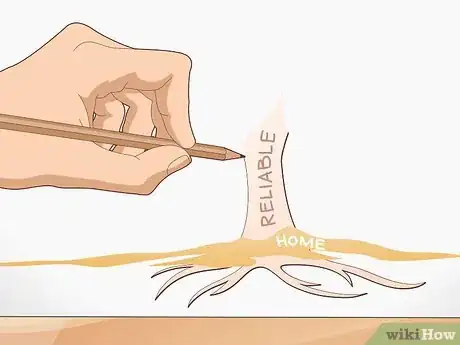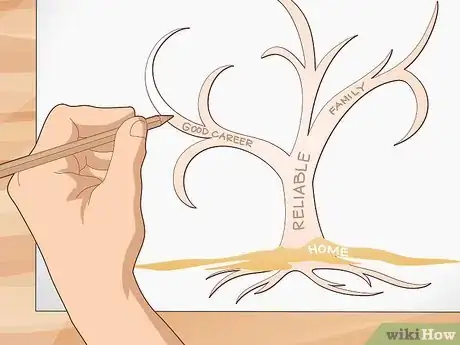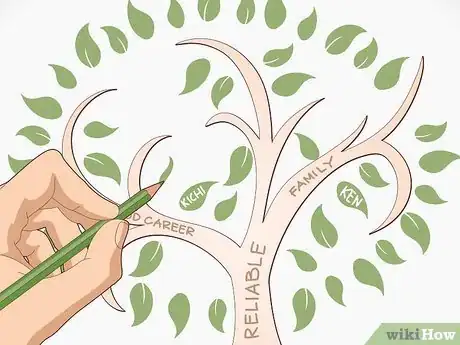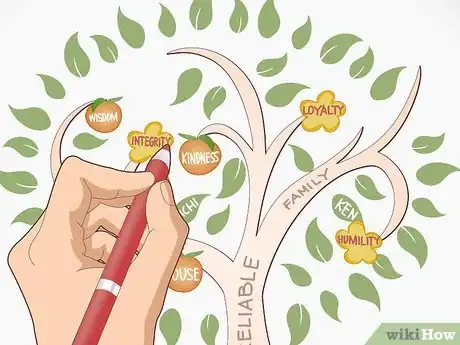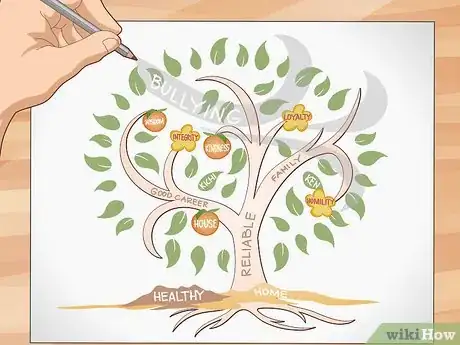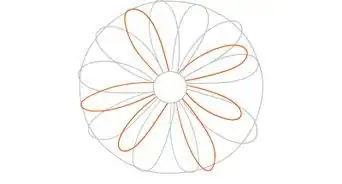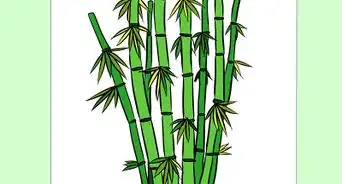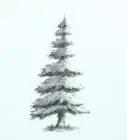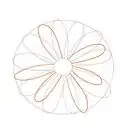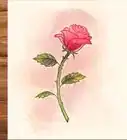wikiHow is a “wiki,” similar to Wikipedia, which means that many of our articles are co-written by multiple authors. To create this article, volunteer authors worked to edit and improve it over time.
This article has been viewed 20,008 times.
Learn more...
The Tree of Life is a narrative therapy technique originally used with children impacted by HIV/AIDS in Africa. It involves illustrating a unique ‘tree of life’, in which many aspects of one's life are conveyed through symbolism.[1] It helps the person to be able to speak about their life in a positive way.[2] Each part of the tree represents something, and the drawing can be as elaborate as the artist would like.[3] Think for a moment about trees with positive associations in your life. You are about to draw one such tree.[4] If you find you need a few tips of drawing, read this article for some basics in tree drawing.
Steps
Drawing Your Own Tree of Life
-
1Draw the roots of the tree. These represent where you come from, and the people in life who have taught you the most. What anchors you when you are upset? Write it here. Your favourite place and your favourite song and book also go here.[5] You can return to your roots later if you want.
- The people of the First Nations may conceptualize the roots as still growing down and out, signifying that it is never too late to become more connected to your culture.
-
2Draw the ground. Where do you currently live? What activities do you choose to do on a weekly basis? Write in the ground the answers to these questions. Is your ground stable, or frequently changing? Consider portraying your ground as flat and smooth vs bumpy.Advertisement
-
3Draw the trunk. On the trunk, write your values and skills,[6] your qualities, what you are committed to in life, and your purpose.[7]
- If it's hard to think of your skills, think about what people you love would say are your skills.
- Consider if there is any skill or talent you have which comes from your roots that you can add to your trunk. Sometimes, in tracing the history of things, you can add to your root system.[8]
-
4Draw the branches. Write your hopes, dreams and wishes on the branches - for yourself and for other people.[9]
-
5Draw the leaves. On the leaves, write the names of important people in your life. They can be people who are still with you or people who have fallen away, like leaves in the wind.[10]
-
6Draw the fruit. The fruit represents the gifts you've been given or the legacies that have been passed onto you.[11] . The gifts can be things like kindnesses you want to remember, or significant material gifts, such as an 18th birthday present.
-
7
-
8Draw a compost heap. This is an optional step. The compost heap represents any challenging, but important parts of your growth - physically, mentally and emotionally.[14]
-
9Consider storms, and how you can get through them. This is an optional step. Storms are challenges you face in life. Write down specific problems, and how you can overcome them,[15] using the skills you have identified in your trunk.
Guiding Others to Make a Tree of Life
Now that you have made your own Tree of Life, you are ready to help others make their Trees of Life, and create a strong forest together!
-
1Make sure the person is old enough to understand the purpose of the activity. They need to be able to share their story from their perspective, to think about where they come from, to think about what they are good at, to think about their hopes, dreams and wishes, and to think about the important people in their lives. Explain this if working with a child.[16]
-
2
-
3Show them example trees, including your own.
-
4Give your participants paper, markers, and pencils and erasers. Ask them to draw the roots of the tree first, growing deep and strong underground. Then tell them that these represent where you come from, and the people in life who have taught you the most. What anchors you when you are upset? Write it here. Your favourite place and your favourite song and book also go here.[19] Reassure the participants that they can return to their roots later if they want.
-
5Ask your participants to draw the ground, and go through with them the same questions you did when you drew your ground. If you know them well you can help prompt them with examples of weekly activities that they can put in their ground.
-
6Ask your participants to draw the trunk. In addition to the questions you went through when you put your trunk together, you may wish to share an anecdote from your own life about a skill you have. Often, the roots or the ground will suggest skills or values to go in the trunk of the tree. Encourage your participants.
-
7Ask your participants to draw the branches, explaining that they represent your hopes, dreams and wishes for the future. For older participants, a broken branch or a tree hollow may represent an old dream that they’ve had to let go.
-
8Ask your participants to draw the leaves, with space to write the names of important people in their lives.
-
9Ask your participants to draw the fruit - be prepared to give examples of what the fruit represents.
-
10Ask your participants to draw the seeds and flowers - gifts that the participant wants to give others.
-
11Tell participants that they can draw a compost heap (optional). If they want to put things that are negative that happened to them, they can still give some air and water to and turn them into good things with some work. Often, people in the compost heap are still in the rest of the tree too.
-
12Discuss storms with your participants, and how we can get through them by using the skills from our trunks (optional). Emphasise that a forest is stronger than a single tree alone, and praise the beautiful forest of life that your participants have created. Go around a circle and allow the participants to discuss their trees of life.
Warnings
- This activity may or may not trigger unpleasant memories for those with bad experiences.⧼thumbs_response⧽
References
- ↑ https://dulwichcentre.com.au/the-tree-of-life/
- ↑ https://dcf.wisconsin.gov/files/cwportal/permanency/pc/pdf/ffe-tree.pdf
- ↑ https://dcf.wisconsin.gov/files/cwportal/permanency/pc/pdf/ffe-tree.pdf
- ↑ https://books.google.com.au/books?id=7VVzAgAAQBAJ&pg=PA11&lpg=PA11&dq=%E2%80%98Riverbank%E2%80%99+position&source=bl&ots=j_6DO83dEl&sig=ACfU3U1p9ASfNvbKvNkkMVC9Xf4gquN1yA&hl=en&sa=X&ved=2ahUKEwjIyrWdm5HpAhVTyTgGHbydDIwQ6AEwBnoECAoQAQ#v=onepage&q=%E2%80%98Riverbank%E2%80%99%20position&f=false
- ↑ https://books.google.com.au/books?id=7VVzAgAAQBAJ&pg=PA11&lpg=PA11&dq=%E2%80%98Riverbank%E2%80%99+position&source=bl&ots=j_6DO83dEl&sig=ACfU3U1p9ASfNvbKvNkkMVC9Xf4gquN1yA&hl=en&sa=X&ved=2ahUKEwjIyrWdm5HpAhVTyTgGHbydDIwQ6AEwBnoECAoQAQ#v=onepage&q=%E2%80%98Riverbank%E2%80%99%20position&f=false
- ↑ https://nathanbweller.com/tree-life-simple-exercise-reclaiming-identity-direction-life-story/
- ↑ https://dcf.wisconsin.gov/files/cwportal/permanency/pc/pdf/ffe-tree.pdf
- ↑ https://books.google.com.au/books?id=7VVzAgAAQBAJ&pg=PA11&lpg=PA11&dq=%E2%80%98Riverbank%E2%80%99+position&source=bl&ots=j_6DO83dEl&sig=ACfU3U1p9ASfNvbKvNkkMVC9Xf4gquN1yA&hl=en&sa=X&ved=2ahUKEwjIyrWdm5HpAhVTyTgGHbydDIwQ6AEwBnoECAoQAQ#v=onepage&q=%E2%80%98Riverbank%E2%80%99%20position&f=false
- ↑ https://firefly255.wordpress.com/2016/05/20/narrative-therapy-project-tree-of-life/
- ↑ https://firefly255.wordpress.com/2016/05/20/narrative-therapy-project-tree-of-life/
- ↑ https://dcf.wisconsin.gov/files/cwportal/permanency/pc/pdf/ffe-tree.pdf
- ↑ https://dcf.wisconsin.gov/files/cwportal/permanency/pc/pdf/ffe-tree.pdf
- ↑ https://books.google.com.au/books?id=7VVzAgAAQBAJ&pg=PA11&lpg=PA11&dq=%E2%80%98Riverbank%E2%80%99+position&source=bl&ots=j_6DO83dEl&sig=ACfU3U1p9ASfNvbKvNkkMVC9Xf4gquN1yA&hl=en&sa=X&ved=2ahUKEwjIyrWdm5HpAhVTyTgGHbydDIwQ6AEwBnoECAoQAQ#v=onepage&q=%E2%80%98Riverbank%E2%80%99%20position&f=false
- ↑ https://dcf.wisconsin.gov/files/cwportal/permanency/pc/pdf/ffe-tree.pdf
- ↑ https://dulwichcentre.com.au/wp-content/uploads/2014/01/getting-through-the-storms.pdf
- ↑ https://dcf.wisconsin.gov/files/cwportal/permanency/pc/pdf/ffe-tree.pdf
- ↑ https://books.google.com.au/books?id=7VVzAgAAQBAJ&pg=PA11&lpg=PA11&dq=%E2%80%98Riverbank%E2%80%99+position&source=bl&ots=j_6DO83dEl&sig=ACfU3U1p9ASfNvbKvNkkMVC9Xf4gquN1yA&hl=en&sa=X&ved=2ahUKEwjIyrWdm5HpAhVTyTgGHbydDIwQ6AEwBnoECAoQAQ#v=onepage&q=%E2%80%98Riverbank%E2%80%99%20position&f=false
- ↑ https://dcf.wisconsin.gov/files/cwportal/permanency/pc/pdf/ffe-tree.pdf
- ↑ https://books.google.com.au/books?id=7VVzAgAAQBAJ&pg=PA11&lpg=PA11&dq=%E2%80%98Riverbank%E2%80%99+position&source=bl&ots=j_6DO83dEl&sig=ACfU3U1p9ASfNvbKvNkkMVC9Xf4gquN1yA&hl=en&sa=X&ved=2ahUKEwjIyrWdm5HpAhVTyTgGHbydDIwQ6AEwBnoECAoQAQ#v=onepage&q=%E2%80%98Riverbank%E2%80%99%20position&f=false
